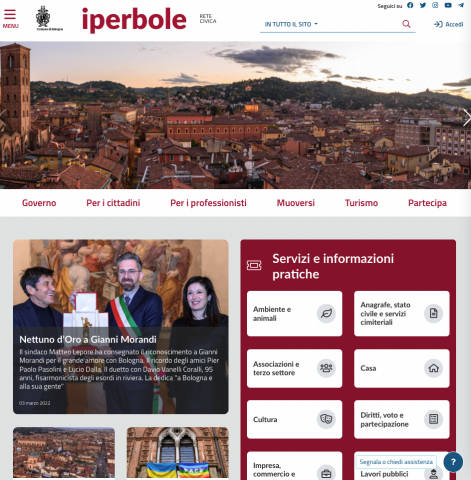New Civic Network - Nuova Rete Civica - Bologna
Bologna (Italy)
The new municipality website aims to create the "Citizen's Digital Home", built around the needs of the citizen. The municipality website will be a communication instrument for the institution and a catalogue of online services, but above all it will be a tool at the citizens' disposal. The project started for the Municipality of Bologna and will be adopted by 28 different municipalities in the Emilia-Romagna Region.
The question that guided the design phase was therefore: as a citizen, what can the website of my municipality be useful for?
I want to find news and insights of general interest and I want to automatically receive those of my specific interest.
I want to easily find the services I need and discover opportunities that I do not know and that may be of interest for me.
I want to be able to interact with the Municipality offices in a convenient way and I want to receive support.
I want to have a space where I can find my documents, my data and see the status of my applications.
I want to be able to participate in the initiatives and projects of my community.
-Customisation and profiled services.
-Proactivity and predictability: notifications, timely alerts and communications, analytics and recommendations.
-Easy-to-find services, information and tools.
-Clarity of information and easy way to complete tasks.
-Usability and Accessibility: Clear and understandable language (no bureaucratese). Inclusive services.
-Cross / multi-channel: Transversal online and offline services, consistent communication on all points of contact
-Ecosystem: Standards, homogeneity and coherence for the digital agenda of the metropolitan city
-Enhancement and involvement of the citizens in the civic network and in common choices, in order to develop trust
-Open and big data as an ecosystem asset
- Management of the responding process.
- Operator's desk to facilitate requests management.
- Centrality of the user in reviewing the processes of access to services, providing the entire process in a digital, personalised and assisted way;
- 'Digital first', with attention, however, to make the physical channel available to reach weak users (even with methods such as 'proximity tutors') and providing full integration between the channels (a service can start virtually and then be continued physically);
- Complete integration with national enabling platforms (payment platform, authentication platform, digital identity, ...);
- Interoperability between PA systems to ensure the ""once only"" principle;
- Redesign of counter services in a native digital key (digital agendas for appointments, remote counter via videoconference, virtual assistant)
1) DISCOVERY OF CITIZEN'S EXPECTATIONS:
- questionnaire open to all interested parties to understand what they use and their expectations (more than 1000 replies);
- analysis of the responses (and their evaluation / integration) with personnel who deal with citizen in the communication department.
2) CO-DESIGN OF THE SERVICE:
- workshops to collect ideas and present proposals, with groups of users representing the possible 'personas' who use the site;
- analysis for use cases, specific service contexts;
- functional design and creation of wireframes / prototypes;
- verification by users and collection of feedback both through scheduled sessions and through 'guerrilla tests';
3) USER-TEST OF THE COMPONENTS
- agile approach for the implementation;
- test sessions conducted with a group of representative users.
4) FINAL TEST AND CONTINUOUS CHECK:
Evaluation of the test results for individuals with diversity and / or disabilities by specialised people.
Functional test: functioning of the elements of the site and pages: links, buttons, videos, etc.
Accessibility (WCAG 2.1 Guidelines): Perceivable (ease of access to content), Operable (ability to interact with content), Understandable (ability to make content clear and simple), Robust (ability to use accessible technologies)
Usability: Semantics (text, images, video), Interface (graphics, colours, animations), Navigability (structure, menus, help, indicators)
Feedback: OK / KO, violations / verifications, satisfaction
